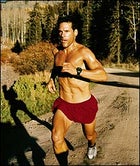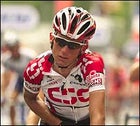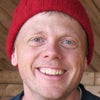Dean Potter//31//Climber
Wellness Resolution
Make 2004 your best fitness year ever by .Potter has long employed a total-body fitness approach to redefine the sport of climbing. In September 2002, he completed a historic feat by free-climbing the main faces of El Capitan and Half Dome in less than 24 hours. As he tackles increasingly dangerous challenges, Potter is paying more attention to how he approaches what he does off the rock. “When I do stuff where death could be a real consequence, it makes me want to live right,” says Potter. “And it really drives home the importance of living right, not sometime in the future, but now. For me that starts with respecting the people around you, your environment, and yourself.” “I want my health to be perfect when I’m pushing the edge. I do yoga. I meditate, and when I’m not climbing, I focus on breathing deeply all day long,” Potter says. “I hydrate obsessively, limit processed foods, and make a conscious attempt to eat and drink pure things, organic foods. I’ve noticed that these things stay with me longer than processed foods and that I’m more consistent in my climbing and my life—there aren’t so many highs and lows.”
Natural Fit
to access şÚÁĎłÔąĎÍř‘s total-body fitness plan.Paula Newby-Fraser 41//Triathlete
Newby-Fraser’s 23 Ironman Triathlon wins since 1986, including eight Ironman World Champion titles, are credited to her relentless training—up to 30 hours a week. But it wasn’t all swimming, biking, and running. She also made yoga, massage, and her favorite, Pilates, part of her regimen.
“I never quit doing some semblance of strength training during the year,” says the San Diego- based Newby-Fraser. “It’s the foundation of everything I do in competition. But there are only so many miles you can pound out of yourself before you start wasting away. Pilates is one of the most well-balanced forms of exercise, because it combines flexibility training with the benefits of weight lifting.”
Even though Newby-Fraser recently stepped down from the pro ranks, she’s not slowing down. She currently trains ten hours a week, which includes two Pilates sessions, and competes in six triathlons or running races a year.
Carl Swenson//33//Nordic Skier and Mountain Biker
When last September’s Mountain Biking World Championships ended in Lugano, Switzerland, five-time U.S. national-team member Swenson put his Tomac bike in storage, broke out his Fischer cross-country skis, and joined his teammates on the U.S. national nordic squad for the winter. His results speak to the effectiveness of split-personality endeavors. At the 2003 World Cross Country Ski Championships, he placed fifth, the third-best result in U.S. men’s history.
“My cycling teammates always say, ‘I can’t believe you’re gonna race skis all winter,’ ” he says. “But it’s actually an advantage. I get really motivated by the dramatic improvements in strength I see when I get on the skis or bike after having been off them for a long time. If you’re just doing the same sport the whole year, it can feel like you’re never going to get any better at it.”
Baron Baptiste//40//Yoga Teacher
The man who brought yoga to the Philadelphia Eagles, Baptiste made his name with Power Vinyasa Yoga, his trademarked athletic technique that uses body heat to loosen muscles and ligaments, and that, he says, will help you achieve peak performance.
“Since most sports training is one-dimensional, the body takes on one-sided characteristics that can lead to injury,” says Baptiste, who also practices meditation and taekwondo. “To avoid that, the body needs to be counterbalanced, whether you’re a skier or a marathoner. Once your body is balanced, you won’t be afraid you’re going to pull a hamstring or throw out your back. Psychologically, that knowledge reduces your fear-and-stress factor, and sports mastery is all about being relaxed under pressure. Yoga will train you to achieve that.”

Dean Karnazes//38//
Ultramarathoner
At his 30th-birthday bash, Karnazes, then a professional windsurfer living in San Francisco, ran out of the party and didn’t stop until he had jogged to Half Moon Bay, 30 miles later. Since then, he’s worked up to a 226.2-miler around the Bay Area in 57 and a half hours. His next goal is to run the Sierra’s Western States 100 route, in the middle of winter.
The quintessential ultramarathoner, Karnazes takes exquisite joy from the fundamental act of the sport he describes as the zenith of endurance. “There aren’t any distractions,” he says. “You’re focused on the goal of reaching the finish, and you either get there and succeed or you don’t and fail.” To get to the finish line, he employs a simple strategy: Think only about the present. “You’ve got to focus on micro-goals when faced with a big challenge,” says Karnazes. “If you can’t stand anymore, you say, ‘OK, just get up.’ When you get up, you say, ‘OK, just make it to that stop sign up the road.’ When you reach the stop sign, you say, ‘OK, I’ll get to that tree up the street.’ That’s how you run 200 miles.”

Tyler Hamilton//32//Cyclist
Lance beat cancer, but Hamilton may be the toughest man in cycling. He’s most famous for finishing second in the 2,081-mile-long Giro d’Italia stage race in 2002—with a broken shoulder—and for breaking his collarbone in a crash during the first stage of last year’s Tour de France yet finishing the overall race in fourth place.
While Hamilton takes advantage of daily massages as well as frequent chiropractic adjustments and acupuncture to revive his battered body during racing season, it’s his mental fortitude that carries him forward. He credits his capacity to work through pain to his childhood days skiing and racing down the windblown, subzero slopes of New Hampshire’s Wildcat Mountain. “When you’re skiing in that kind of weather, if you can’t grit your teeth and suck it up, you’re gonna have a hard time,” he says. “When you accept that you’re in pain, you can free your mind to go on to other things. If all you concentrate on is the negative, then you might as well quit. Take a deep breath, relax, and move on.”
Chris Sharma//22//Climber
In 2001, Sharma nailed the hardest climb on earth, Realization, a 5.15a overhang in France that had stymied him 30 times before he succeeded. Surprisingly, he describes the climb as a mental, not physical, challenge. Says Sharma, “To see the whole thing, I had to be in the moment.”
Sharma credits his heightened mental awareness to his daily meditation practice. “Meditation’s important for balance,” he says. “You need to rely on yourself to quiet the mind. I know having more of a mental calm has helped me when I try something that’s very difficult. It makes you realize that you’re not always going to be at your best, because when you meditate, you’re paying close attention to your body and how it feels. As a result, you’re at ease when things don’t work out. You learn to appreciate the lows, just let them happen, learn from them, and go back and try again.”
